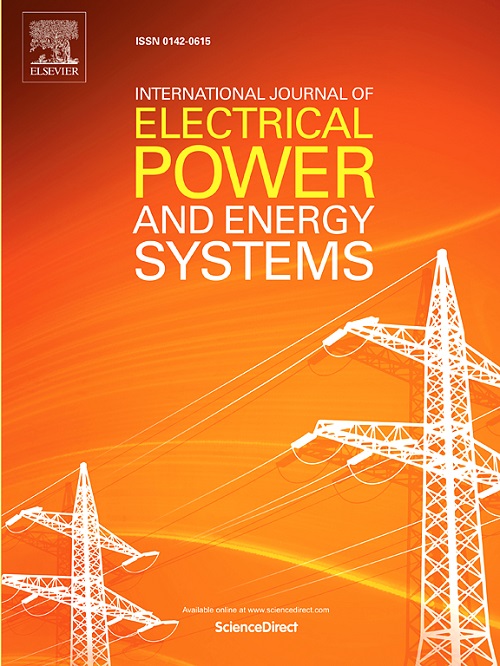An enhanced multi-objective reactive power dispatch for hybrid Wind-Solar power system using Archimedes optimization algorithm
IF 5
2区 工程技术
Q1 ENGINEERING, ELECTRICAL & ELECTRONIC
International Journal of Electrical Power & Energy Systems
Pub Date : 2025-04-15
DOI:10.1016/j.ijepes.2025.110676
引用次数: 0
Abstract
Optimal reactive power dispatch (ORPD) is essential for addressing power system challenges related to distributed generation (DG), particularly from renewable energy (RE) sources such as wind and solar. The intermittent nature and uncertainty of these energy sources, influenced by varying wind speeds and solar irradiation, complicate their integration into power systems. This paper proposes a solution to the ORPD problem in systems with RE-DG integration using the Archimedes Optimization Algorithm (AOA). The uncertainties of wind and solar power generation were modelled using Weibull and lognormal probability density functions (PDFs), respectively, and the optimization model was tested using a scenario-based method. The AOA was applied to the IEEE 57 bus system to minimize power loss, voltage deviation, and voltage stability index (VSI). The results demonstrated that AOA contributed to a 15.7% reduction in power loss, and an 83.9% enhancement in VSI compared to the base case. In the multi-objective optimization scenario, AOA achieved a 7.1% reduction in power loss, with an additional 11.6% improvement upon the integration of DGs. The performance of AOA was also compared with other metaheuristic algorithms, demonstrating superior results in terms of tracking accuracy and convergence speed. AOA outperformed the multi-objective ant lion optimization (MOALO) and the Levy-based Interior Search Algorithm (LISA) in terms of power loss reduction and voltage stability. AOA achieved a 1.83% lower power loss and a 29.67% lower VSI compared to MOALO. When compared to LISA, AOA achieved a 1.68% lower power loss, demonstrating its superior optimization capabilities. These findings confirm that AOA is a highly effective method for solving the ORPD problem, accounting for renewable energy uncertainties and improving overall system performance.
使用阿基米德优化算法的风光互补发电系统增强型多目标无功功率调度方法
优化无功功率调度(ORPD)对于解决与分布式发电(DG),特别是风能和太阳能等可再生能源(RE)相关的电力系统挑战至关重要。这些能源的间歇性和不确定性,受不同风速和太阳辐射的影响,使其与电力系统的整合变得复杂。本文利用阿基米德优化算法(Archimedes Optimization Algorithm, AOA)解决了RE-DG集成系统中的ORPD问题。分别采用威布尔和对数正态概率密度函数(pdf)对风能和太阳能发电的不确定性进行建模,并采用基于场景的方法对优化模型进行验证。将AOA应用于ieee57总线系统,以最小化功率损耗、电压偏差和电压稳定指数(VSI)。结果表明,与基本情况相比,AOA使功率损耗降低了15.7%,VSI提高了83.9%。在多目标优化方案中,AOA实现了7.1%的功率损耗降低,在集成dg后又实现了11.6%的功率损耗降低。将AOA算法的性能与其他元启发式算法进行了比较,结果表明AOA算法在跟踪精度和收敛速度方面优于其他算法。AOA在降低功耗和电压稳定性方面优于多目标蚁狮优化算法(MOALO)和基于levy的内部搜索算法(LISA)。与MOALO相比,AOA的功耗降低了1.83%,VSI降低了29.67%。与LISA相比,AOA的功耗降低了1.68%,显示出其卓越的优化能力。这些发现证实了AOA是解决ORPD问题的一种非常有效的方法,考虑了可再生能源的不确定性,提高了系统的整体性能。
本文章由计算机程序翻译,如有差异,请以英文原文为准。
求助全文
约1分钟内获得全文
求助全文
来源期刊
CiteScore
12.10
自引率
17.30%
发文量
1022
审稿时长
51 days
期刊介绍:
The journal covers theoretical developments in electrical power and energy systems and their applications. The coverage embraces: generation and network planning; reliability; long and short term operation; expert systems; neural networks; object oriented systems; system control centres; database and information systems; stock and parameter estimation; system security and adequacy; network theory, modelling and computation; small and large system dynamics; dynamic model identification; on-line control including load and switching control; protection; distribution systems; energy economics; impact of non-conventional systems; and man-machine interfaces.
As well as original research papers, the journal publishes short contributions, book reviews and conference reports. All papers are peer-reviewed by at least two referees.

 求助内容:
求助内容: 应助结果提醒方式:
应助结果提醒方式:


